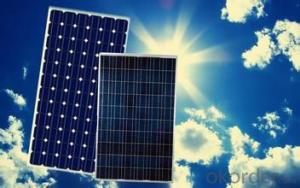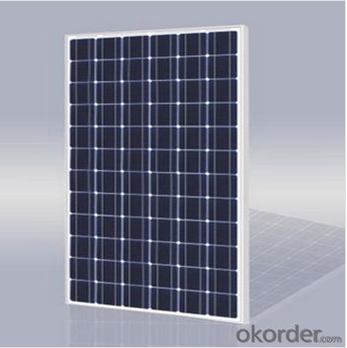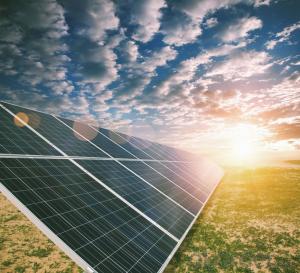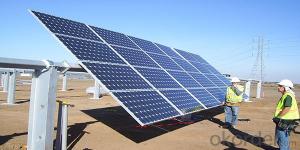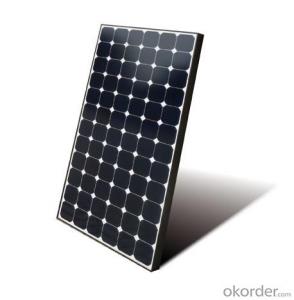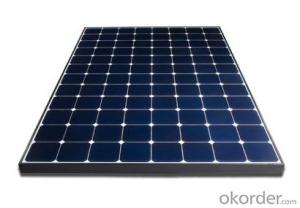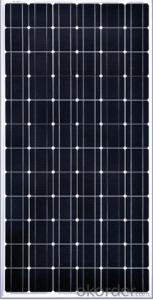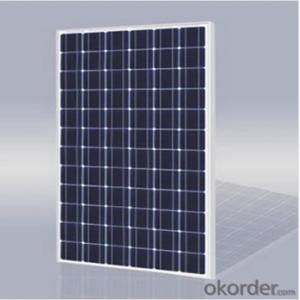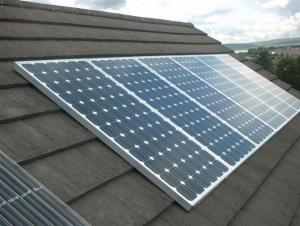Solar Panels Home Use - 65w CNBM Polycrystalline Silicon Panel
- Loading Port:
- China main port
- Payment Terms:
- TT OR LC
- Min Order Qty:
- 100 watt
- Supply Capability:
- 1000 watt/month
OKorder Service Pledge
OKorder Financial Service
You Might Also Like
Specification
65W CNBM Polycrystalline Silicon Panel for Home Using
Production description
Most solar modules are currently produced from crystalline silicon (c-Si) solar cells made of multicrystalline andmonocrystalline silicon. In 2013, crystalline silicon accounted for more than 90 percent of worldwide PV production, while the rest of the overall market is made up of thin-film technologies using cadmium telluride, CIGS and amorphous silicon[7]Emerging, third generation solar technologies use advanced thin-film cells. They produce a relatively high-efficiency conversion for the low cost compared to other solar technologies.
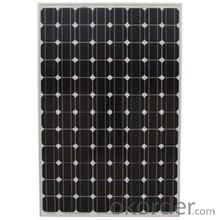
Feature
Optimized design for ease of soldering and lamination
Long-term stability,reliability and performance
Low breakage rate
Color uniformaity
Physical characteristic
1. Rigorous quality control meets the highest international standards.
2. High-transmissivity low-iron tempered glass, strong aluminium frame.
3. Using UV-resistant silicon.
4. IS09001/14001/CE/TUV/UL
- Q: how much energy or electricity a solar panel produces?
- First, okorder /... Second, as a general rule of thumb, you can generate at most 00 watts of power (.Kwh) per 2 square feet of roof space. I have had to revise my own estimates after building a solar array in my yard using high grade solar panels. Solar panels do not put out their peak rating all the time. NOTE: I am not paid nor given any compensation by solar interests.
- Q: We are considering getting solar panels for our home just south of Birmingham, AL. We know a little and are trying to educate ourselves the best we can. But we are having a hard time finding anyone around this area. We have done the yellow page thing, and some quot;green places around town. But to no luck.....
- Any electrical contractor could likely install them, and there are several Internet businesses that sell solar panels. You likely have no place there to get the kind of large panels you need for a house. Look at your local regulations. Your utility may not allow grid-tie, so you may have to set up an off-grid system with batteries and use separate wiring or a transfer switch. One thing a lot of people neglect is hail protection. In Birmingham, you're likely to have large hail (larger than golf ball size) every couple of years in the spring. You need to work out a way of covering them in advance of severe weather. Most panels will take up to golf-ball size hail with no problem. DK PS, I've done this myself, and have considerably more information. Email if you're interested.
- Q: in the afternoon sun heat increases to high level due to which the panels heats up very high now my question is this heat will effect the panels life time and will damage the panels or not ??
- Most experts believe solar electric modules have a lifespan of at least 25 to 30 years and most manufacturers provide a warranty for this period. However, the truth is that we don't really know for sure since most modern solar panels have not been in existence that long. Many experts believe the actual number could be much higher, possibly as much as 50 years. What is very clear is that solar modules are extremely durable and lose very little of their energy generating capacity over time. From: bit.ly/tpTfK
- Q: can this amount of solar charge these batteries.
- Well you are stating the solar panel powers but no mention of their voltage??. Yes, they should do the job. I suspect the lack of blocking diodes may be your problem, assuming you have done the homework. You have 6 battery cells at 2 volts each, that is ...err..2 volts, assuming you have them connected in series. Count the number of cells on the solar panels and maybe we have a starting point. One solar cell is 0.6 v, in this case you would need a minimum of around 30 cells (physically it will probably be 32 to make it 'square'), you need a fair bit of over- sizing in that direction. Solar panels are resistive when not illuminated so must have a blocking diode included to prevent the batteries from discharging into the solar panels at night. Check that each array has a blocking diode included, if not add them. Solar power is pretty useless unless you have loads of sunshine. You seem to have gone through a bit of trouble and expense on this one, so give me some basic facts and I will help you through it. Update 7 Dec If the batteries take 20 hours to fully charge and there are 0 hours of sun each day then the batteries will be fully charged in 2 days. The question was, can the battery be charged, answer is yes, it can. There is no mention of load. If the batteries are not charging there is something wrong.
- Q: Can solar panels be used in cloudy regions?
- Yes, solar panels can still be used in cloudy regions. While solar panels are more efficient in direct sunlight, they can still generate electricity in cloudy conditions. Clouds diffuse sunlight, but some sunlight still reaches the solar panels, allowing them to produce power. However, the energy output may be lower compared to sunny regions.
- Q: First of all is it possible? I do not know how much electricity my dehumidifier but could someone give me an idea of how much this would cost to do? A link to a solar panel or equipment that would do the job would be nice too.Thanks in advance.
- Great! The general steps are: . Determine how much power your humidifier uses (watts). Multiply the amperage x 5 (Assuming you're in the U.S.) 2. Determine what size solar panel you need (this will be in watts as well). Consider that the rating for a solar panel is optimal. That means that's the best it will be in direct sunlight. 3. Determine if you want a battery in the system. A battery will store energy from the solar panel so you can use it later. Helps for cloudy days or when the panel otherwise doesn't output the same power as the humidifier uses. 4. Figure out the right charge controller. You need to regulate the power from the solar panel into either the humidifier or the battery setup. 5. Tie it all in together, using proper electrical connections. It can be complicated, but its certainly a good feeling to get power from the sun. Good luck!
- Q: Where can I find the info (sites) that clearly gives the anatomy of a solar panel?Likewise, I want to know where can I find (sites) the solar panel that produces 3.75 v? Thank you very much!!!
- You've probably seen calculators that have solar cells -- calculators that never need batteries, and in some cases don't even have an off button. As long as you have enough light, they seem to work forever. You may have seen larger solar panels -- on emergency road signs or call boxes, on buoys, even in parking lots to power lights. Although these larger panels aren't as common as solar powered calculators, they're out there, and not that hard to spot if you know where to look. There are solar cell arrays on satellites, where they are used to power the electrical systems. You have probably also been hearing about the solar revolution for the last 20 years -- the idea that one day we will all use free electricity from the sun. This is a seductive promise: On a bright, sunny day, the sun shines approximately ,000 watts of energy per square meter of the planet's surface, and if we could collect all of that energy we could easily power our homes and offices for free.
- Q: Can solar panels be installed on bridges or highways?
- Yes, solar panels can be installed on bridges or highways. In fact, there are several projects around the world where solar panels have been installed on bridges and highway infrastructure. These installations not only generate clean energy but also utilize underutilized spaces, contributing to sustainable and efficient use of resources.
- Q: Does San Francisco get enough sunshine to really make solar panels a viable option for creating a self-supporting home? Certainly a wind turbine would be a good source of energy, but what about solar panels? Does S.F. get enough sunshine to justify using solar panels? It's overcast a lot in the Bay Area, are there any solar panels better than others for a climate like this?
- Yes, San Francisco gets enough sunshine. That will vary depending on your site location, some are better than others. The best way to find out how much electricity your specific location can generate is to get a quote from a solar company. I am in the process of getting PV's installed on my home in the Sacto area and got quotes from 3 companies. My home is in a good, not optimal possition and depending on where on the roof I place the panels my efficiency will vary. Also depending on the brand of panels, some will take less square footage on the roof to produce the same amount of electricity. The price on all 3 were very close to each other. All 3 companies I dealt with gave a no cost/no obligation quote, and they were are very knowledgeable about the specific utility rebates I would be eligable for. I say it is well worth the time to check it out. My system should be going onto my roof in just a few more weeks. I was able to get nearly 50% of my cost refunded by my utitlity, plus my federal tax rebate. My system should be paid for in about 6 years.
- Q: I am doing a school project and we need to find the cost of solar panels for our school. The problem is i don't know what size the system needs to be. Is it 000 watts or 000000 watts?Also can you find the cost of the system?Thanks
- Good question I am uncomfortable doing my child's homework so I will not complete the assignment for you. I am also always willing to help. Having the kWh is a great start. You must also ask the question when you size a system is there any way to reduce this load. Each kWh that you do not have to produce saves significant cost to the system. Next what type of system grid tied or off grid the two systems will have very different size needs and overall cost. I googled PV system sizing and got the below link. at first glance I like it. You can do the same for system cost. I also included a trade link for your review factors in sizing system type amount of bill offsetting geographic location site location track mounted or fixed and more Should you need additional help you can email me I will not do your work for you but I can either verify it or point you in the right direction
Send your message to us
Solar Panels Home Use - 65w CNBM Polycrystalline Silicon Panel
- Loading Port:
- China main port
- Payment Terms:
- TT OR LC
- Min Order Qty:
- 100 watt
- Supply Capability:
- 1000 watt/month
OKorder Service Pledge
OKorder Financial Service
Similar products
Hot products
Hot Searches
Related keywords
